|
One Story from the Western Desert that is almost the Stuff of Science Fiction !
Explosions in the Desert
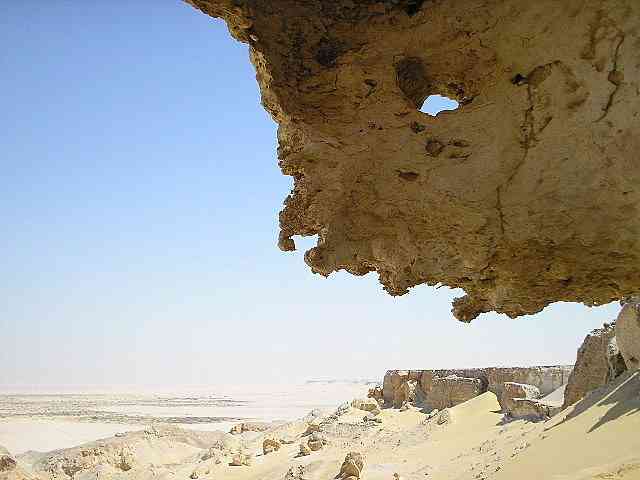
Above....Looking up to the escarpment where the covert activity took place
Look at the next picture below... The escarpment is a little over 500 feet high. In the top right pic. The sand dunes do not respect
height. This dune cuts across the top of the escarpment and continues below on its line into the valley. The section of escarpment
is a prominatory which stretches on a fairly straight line for about a mile. The very isolated location out in the desert is about 80
miles from the Great Pyramid, and about 20 miles from the nearest primative village. The nearest Coptic community is nomadic and
spread over a distance of 6 miles or more away.
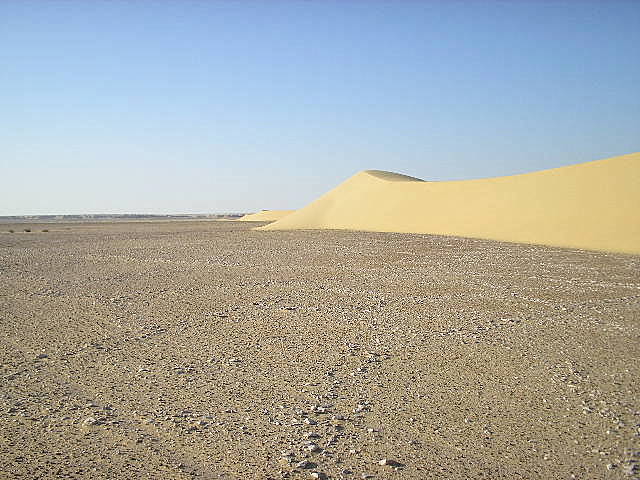
From the top of the escarpment looking out over the edge to the valley (vegetation right/centre)
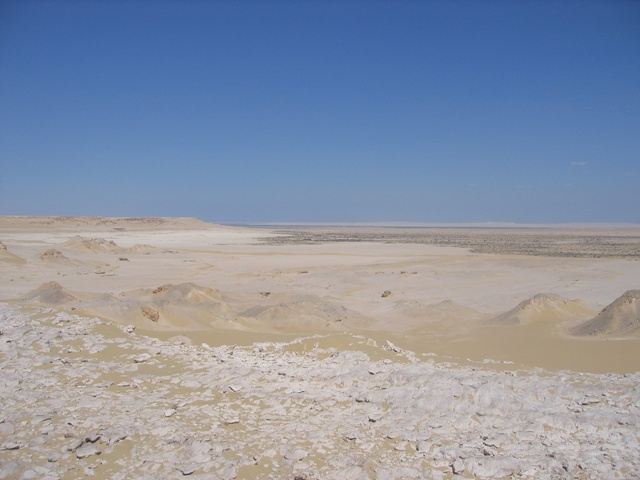
Finally a perspective from the valley floor looking up to the top of the escarpment where the action took place !
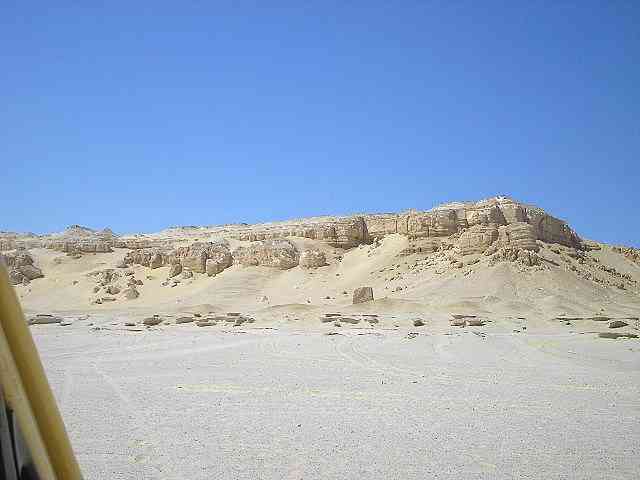
The Incredible Story
Only a few years ago, the nomadic Coptic Monks in this highly protected region noticed nightime activity many miles across the
valley. Naked flame lights were seen moving about. A few of the Monks decided to keep a closer watch and documant the activity.
The records are astonishing. Poor villagers from far away were being trailered into the area under darkness in working parties. The
4x4 vehicle being used was an expensive model, but the open trailer being pulled behind it was basic.
The gangs stayed in the small wilderness area for only a day, or sometimes for several days. Always it was the light from their fires
that alerted the distant watchers. Even over such distance the sounds of their activities also attracted attention. However, no one
could fathom what their purpose was! Each change of shift meant a journey for the men which avoided a much simpler but more
exposed route. Instead they wound their way an inconvenient distance over rough ground to keep their presence secret.
The watchers saw how the men spent their rest time in poorly selected hollows to conceal their presence and shield the sun.
There is almost nothing obvious to distinguish this lost area of escarpment. The surface crust is fossilised reef; now rock hard
limestone sometimes many feet in thickness. But these gangs of men slaved to try and hammer, bash, dig, and sometimes
dynamite their way through the crust. The result across one section of escarpment surface stretching quarter of a mile, is a surface
peppered with hollows bounded by the rocks they managed to excavate.
A Pic of the deepest hollow dug and blasted out is shown below. Just below centre right notice the darker sand colour. This is where
there was definite dampness. The cairn was built by the workmen as a location beacon. The location is so remote that it is difficult
to find even when you know it is there.

Some of the excavations already filling with blown sand.
You can just make out the outline of the excavated rock surrounding the surface of other excavations in the far ground.
.jpg)
None of the hollows seem very deep. See how the encroaching sand has begun to fill them again. Study the pics. carefully and
you will see their outline. The story does not nearly end there though. Close to these hollows, and just over the edge of the
escarpment there is a huge section that has broken away.
You will see from the previous panoramic picture - how distant the valley is below, where miles away there are a few water springs
supporting palm trees. Men from the secret working gangs descended at night time and walked out to the valley. They managed
to secure a substantial Palm trunk and actually carried it all the way to the top of the escarpment by hand. It must have taken
immense effort.
You will see in a couple of other pictures how this trunk was slung across from the edge of the escarpment to the rock that had
split away. It seems there was a deep narrow fissure running alongside the rock. The men dug into the fissure and began to
create a deepening shaft. As it grew deeper, they needed the Plam Tree log to make a windlass so they could be lowered deeper
and deeper into the ground.
You can see how the Plam tree log was rested across the gap formed above the Fissure to give a windlass point. The Fissure runs
from the crook of the Rock to a line alongside it. Check the rock spoil from the Fissure excavation and from other hollows dug nearby.
.jpg)
The next picture from below the rock tells a lot. The shadow from the Plam log makes a Parasol shadow with the rock shadow. The
point where the two shadows meet is almost directly over where the shaft was sunk into the fissure. In fact it is still possible to
discern the circle of the shaft despite the sand obscuring it. From here the men toiled to dig deep into the ground, using natural
concealment from the rock and a deep sand hollow formed under its front overhang. The rock overhang gave the main picture at
the top of this page viewed in the other direction out to the valley.
.jpg)
But the final pics. tell of even something else! Around the headland a short way from these activities, the workers had been
directed to work in another two known places. Just around the headland, the men dug into the bottom of the exposed cliff. The
digging area can be identified as the dark patch upper centre of the picture.
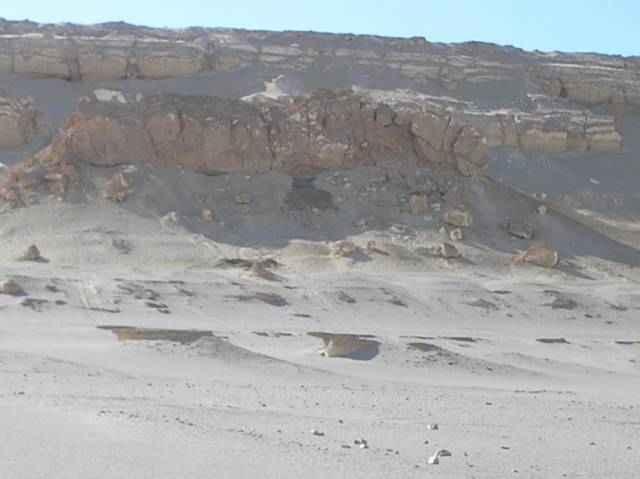
Beyond the cliff edge of the escarpment, the side drops to about half its height before the spoil begins to slope away to the valley
floor. At a point where the spoil slope meets with the cliff face, the men once again moved tons of soil and rock in an effort to dig
into the bottom of the cliff. You can see this clearly in the pics. Below is a closeup from above. The dig area is of many square yards.
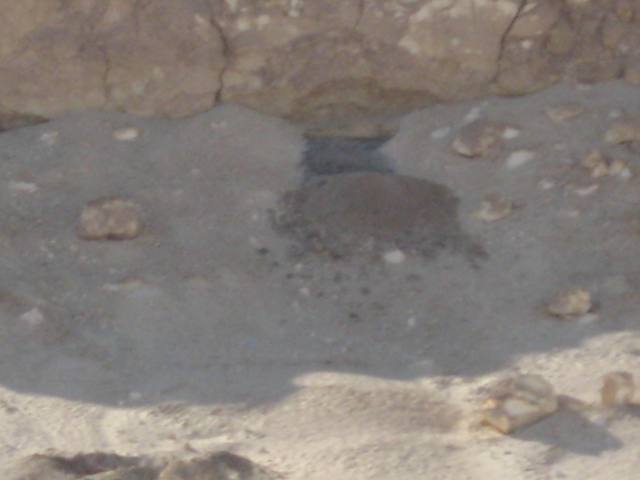
And in a final location....
A little lower down from this position where the compacted spoil begins to level out, the men had put in a herculean effort to dig into
the ground itself. This time the result was the shifting of an estimated 150 tons of soil by hand, and a resulting hollow depression of
moderate size. The following picture looks down the slope from the level of the excavation above. You can just see the spoil slope.
The vehicle had to be blurred out (just above where the lower hollow was dug out.)
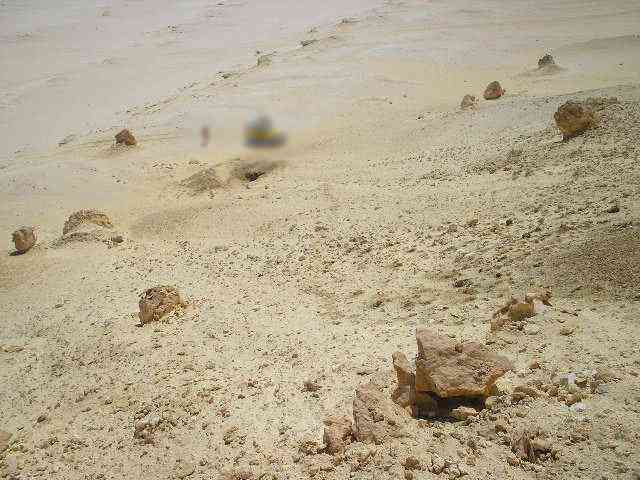
The Story Continues
These activities continued sporadically over a period of two years. They may have continued but the presence of the working
gangs became more noticable to the indigenous Coptic desert community. The gangs became careless at night, and made use of
dynamite more often.
As already said, this vast desert area is highly protected despite the complete remoteness of their location. No one is meant to be
there at all without special permission. Eventually senior Church men and Government Ministers were discussing the issue and the
growing protests from the region.. As the protests suddenly reached Political levels, suddenly the mysterious clandestine activities
stopped in unison !
Shortly before the final stoppage, the camp of the current working gang was purely coincidentally raided between the changeover
of the working parties. At the very same time as politics intervened, a couple of the Monks had had enough of the violation and
had directly intervened. Equipment was rifled or hidden to try and deter the activity. Nothing more was said
or done and all we have to unravel the mystery, is hearsay and speculation; or well ......almost!!
We have visited the site; taken copious notes, photographs, and measurements.
We noted how the shaft that had been sunk to follow the fissure, had been deliberately filled with sand to block it again.
We noted also how a couple of the deepest hollows on the top surface of the escarpment, seemed hollow, almost as if a deeper
shaft at their bases had been covered over with sheet materials and then concealed with a depth of sand. We were not equipped at
the time to investigate more thoroughly ourselves. Strangely at a point on the side of one hollow, the soil was clearly damp. We
could fathom no reason for this in the baking sun!
We heard during an interview with a village who claimed to have been one of the men recruited to work there that something was
found at the fissure location. He claimed when they dug to a certain depth they uncovered a shaft cut at right angles to the
excavation and disappearing into the escarpment. This was supposed to have happened just before a stop was forced to their
activity.
We were told alongside the shaft there were strange symbols carved at the entrance way. One man had aparrently been detailed
to try and crawl into it, but was pulled out in great fear because of the unstable walls, and the feeling of 'presence.'
We were told no one ventured into it again before the shaft was filled and abandoned.The same villager claimed items 'were'
recovered from below ground and these included objects made of a material that seemed like 'green' granite.The man had some
credibility because he had an intimate knowlege of the site which could only have been gained if he had been there himself.
We heard second hand of the words from a government hydrology surveyor. He had explained to a close aquaintence how sites
were being examined after identification from an Egyptian satellite which was mapping with ground penetrating radar. If so, we
wondered if this could be one of those sites where 'something' was thought to be below ground at that location. Perhaps its 'magic'
height in relation to an ancient time and sea level; and to many other significant sites we encountered, had also played a part.
From later hearsay, we learned the whole costly operation was overseen by someone in senior government office, funded by
money laundered from American sources.
We know quite a bit more than we have revealed about this operation, but the salient parts of the story are not affected. Other
information is retained to protect the many good people whom we know were involved on the righteous side to document and
ultimately halt the whole covert operation. The answer to the mystery is still out there gathering sand.
We cannot vouch 100% for any of the speculated reasoning behind the operation. However we can be sure of a few things.
The operation would have been very costly.
It would have required huge organisation and very senior 'clout' to have been allowed.
It would have required expert organisation especially as explosives were also used.
It would have required incredible motivation for such unbelievable effort for so long at a seemingly worthless remote location.
It would have had to have tied to men at Ministerial level, for the issue to have been stopped following increasing protests at the
same level. It was an operation of significant size.
It was therefore guaranteed to validate the fact that aspects of our ancient past are being kept from us yet again.
Another view of some of the dynamited hollows on the top of the escarpment !
.jpg)
Through the eye of the lookout rock (Lead Picture)
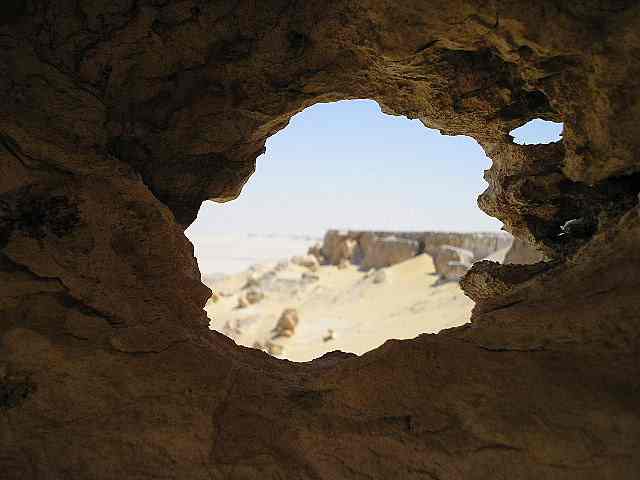
UPDATE AS AT 13th. MAY 2009 :
Egypt State Information Service Culture Minister Farouk Hosni said that the researches conducted via satellites have confirmed
the existence of 132 archaeological sites in Egypt that witnessed no excavations until now.
Farouk Hosni said Egypt's shows full cooperation with the research teams to explore the archaeological sites, and has recently
issued a number of laws seeking to stop the illegal digging in areas likely to contain the buried monuments. He is pointing out
that project of monuments photography via satellite is being implemented in collaboration with the National Authority for
Remote Sensing, Space Sciences and Mubarak City for Scientific Research for the aerial photography and ground laser.
Meanwhile, Secretary General of the Supreme Council of Antiquities (SCA) Zahi Hawas pointed out that satellites took photos for
many archeological sites including Habu city.
It gives us no great satisfaction to say "We told you so!"
More Evidence pages from the Site Index LINK
|